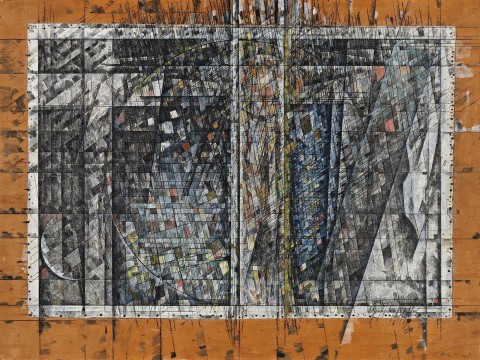CRUCIFIXION, c.1961 – 64
GODFREY MILLER
oil, pen and ink on canvas on plywood
36.5 x 53.5 cm (canvas)
45.5 x 60.5 cm (board)
signed twice lower right: Godfrey Miller
bears inscription upper left: 149 / JH
The Estate of the artist, Sydney
Mr and Mrs John Henshaw, Sydney
Charles Nodrum Gallery, Melbourne (label attached verso)
Private collection, New South Wales, acquired from the above in 2004
Thence by descent
Private collection, New South Wales
Godfrey Miller Memorial Exhibition, Darlinghurst Galleries, Sydney, 16 February – 27 March 1965, cat. 28
Godfrey Miller, Charles Nodrum Gallery, Melbourne, 2 – 28 September 2004, cat. 15 (illus. in exhibition catalogue and on back cover)
Henshaw, J., Godfrey Miller, Darlinghurst Galleries, Sydney, 1965, pl. 28 (illus.)
Ogburn, J., ‘Godfrey Miller, Artist’, The Telegraph, Sydney, 16 February 1965, p. 23
Crucifixion, 1963, oil and pen and ink on canvas mounted on backing board, 45.5 x 61.0 cm, The Holmes à Court Collection, Perth, illus. in Edwards, D., Godfrey Miller 1893 – 1964, Art Gallery of New South Wales, Sydney, 1996, pl. 71, p. 86
Golgotha, 1960 – 64, oil and pen and ink on canvas, 67.3 x 100 cm, private collection, illus. in Edwards, D., Godfrey Miller 1893 – 1964, Art Gallery of New South Wales, Sydney, 1996, pl. 65, p. 75
Godfrey Miller was by all accounts an eccentric man, but also a distinguished and fastidious artist. With what Paul Haefliger, the Sydney Morning Herald art critic, once called a ‘tortuous technique’,1 Miller created complex and deeply cerebral artworks that vibrate with musicality and the intensity of the artist’s personal communion with each of them. His artistic execution, though laborious, was crystallised and refined over many years – each painting going through a gradual process of accretion and removal of lines and colours. They passed through years of successive stages: from monochrome lattices, to the addition of colour and finally the modelling, or what Miller would call the ‘science of drawing’.2 This process endowed his artworks, drawings and paintings alike, with what became his trademark web of intricate cross-hatching, running throughout the composition, and inscribing his compositions in three dimensions. For these reasons, many of Miller’s works are dated with wide tranches, and the artist was said to have considered about 40 of his paintings ‘completed’.3 Crucifixion, c.1962, although not the only painting bearing this title, is the only one that was signed, attesting to the fact that Miller considered this example complete and resolved.
Still fixed to its original preparatory backing board, Crucifixion, displays the complex structure of Miller’s mature work, the ruled vectors running beyond the tacking margins of his pinned canvas and seeping into the grain of the plywood. This labyrinth of filaments supports the harmonious geometry of the composition, featuring at least three cruciform shapes, held together by an expansive open circle form or divine orb. The circular form would become a leitmotif in Miller’s later religious works. A preparatory sketch of the composition of Crucifixion can be found illustrated next to the reproduction of this painting in Godfrey Miller, 1965, edited by John Henshaw, who retained this painting in his personal collection until his death in 2006. Miller was absorbed by the epic, universal aspect of religious thought and found its manifestation in the unity of form: ‘Unity is a non material supersensible thing, it is dynamic, it breathes. Reality is made of cadences, rhythms, intervals, chords, qualities – all that science ignores’.4 All of his apparent abstract mathematical exactitude was supported by a deep symbolic and modernist spirituality rooted in anthroposophical mysticism.5
Miller created multiple versions of his most successful compositions (such as Nude and The Moon, Madonna, Summer, Unity in Blue). Crucifixion, is no exception, belonging to a late series of works, including Golgotha, 1960 – 64 illustrating in semi-abstract terms episodes of Christ’s crucifixion. He reduced visual perception to separate units which could be synthesised and rearranged into facetted semi-abstract prisms. The density of his grid varies, the filaments relaxing in breathy expanses only to concertina in tight clusters elsewhere. Miller uses this variation to create tonal differences that work in tandem with his painted hues of ultramarine, sulfur, vermillion and viridian. The paint is found in the interstices of his weave, laid and confined in lozenges and triangular facets, and shining through like stained glass, supporting the religious foundations of his composition. Miller presents the figure of Christ as a flickering central light, vertically bisecting this composition, his bowed head suggested by a series of delicate arcs to the right of the central cross. Subdued pearly light is filtered through the canvas, an eloquent evocation of divine mystery.
1. Haefliger, P., 'Sydney Group Show is exciting', The Sydney Morning Herald, Sydney, 30 July 1952, p. 2
2. Edwards, D., Godfrey Miller 1893 – 1964, exhibition catalogue, Art Gallery of New South Wales, Sydney, 1996, p. 56
3. ibid.
4. The artist, quoted in ibid., p. 104
5. Miller joined the Sydney Anthroposophical Society in 1940 and found a particular affinity with the teachings of German esoteric Rudolf Steiner, who sanctified the role of the artist as ‘bringer of the Divine to Earth’
LUCIE REEVES-SMITH
